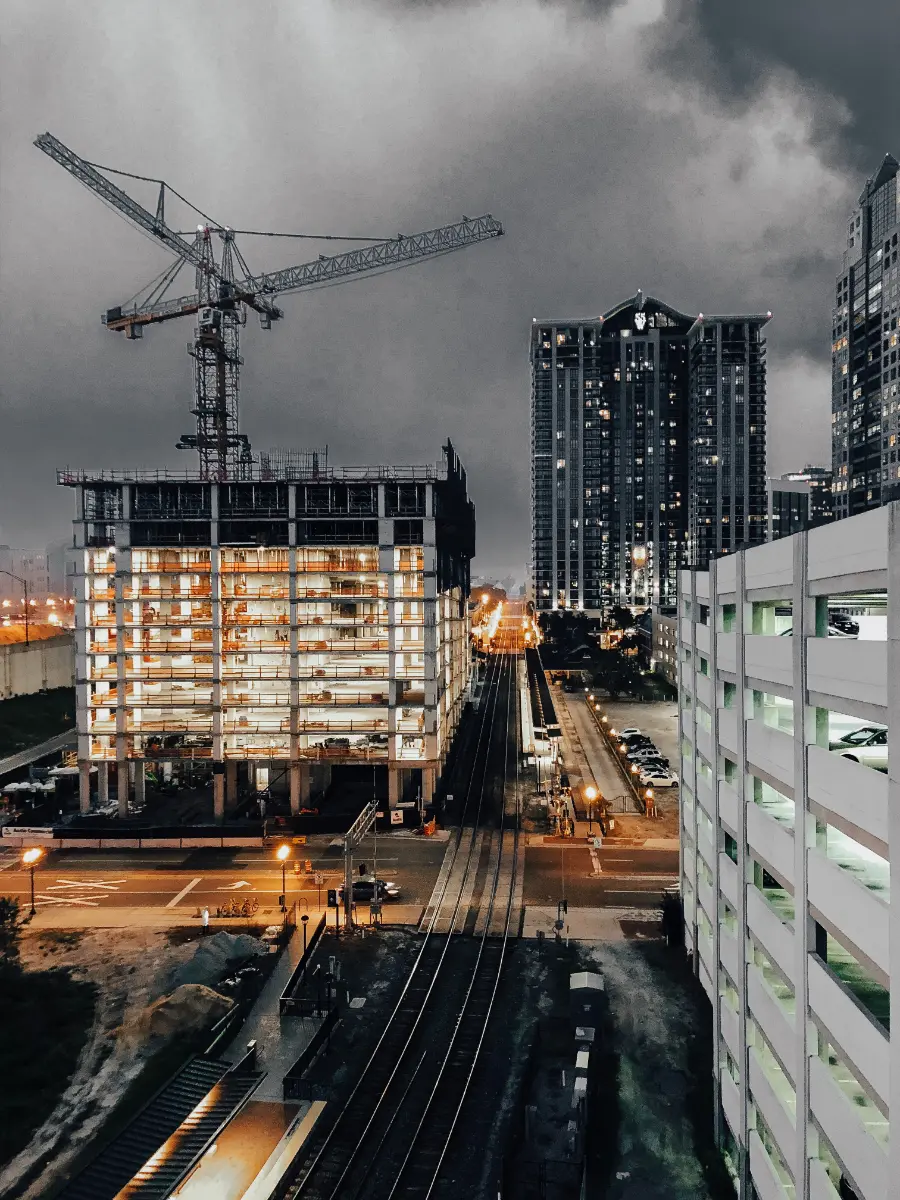· An outlook on challenges and ways forward ·
The construction sector is historically one of the first sectors to be analyzed through a Circular Economy lens. However, with the recent pandemic-induced economic pressure for economic recovery and growth, reducing the environmental and social impacts of the industry seem to be low priority for its actors.
As the industry continues to grow at an impressive pace, it is important to reconsider its current status and the priority areas to work on in order to reduce and halt the environmental damage brought with its development.
An impressive post-pandemic economic growth
Indeed, in 2021 this sector has continued its expansion in two of the world’s largest economies – the US and China. Regardless of the drop in non-residential and public construction works, in the US the construction industry grew continuously throughout the pandemic, mostly powered by the sharp increase in spending in residential construction[3].

In China, despite pressures from market risks as many construction contractors are highly leveraged and may even risk defaulting in the current economic climate (as was the case with Evergrande), the overall construction output has been growing even during the pandemic. In 2020, it increased by 1.3%, in 2021, by almost 7%, and it is forecasted to grow by another 6% this year[4] – here, unlike in the US, growth has been mostly powered by government spending on public works.

Considering that China and the US lead in terms of construction market size, currently making up over 44% of the global market, and being expected to still account for over 40% in a decade[5], it is only natural that the global construction activities growth/contraction tend to follow the paths of these two countries. With both markets seeing strong expansions, this can only mean a growth of the sector in the coming years. Indeed, the forecasts for 2021 and 2022 show a much higher output than in the pre-pandemic years, as visible in the image above[6].
Despite the construction output barely touching pre-pandemic levels in the UK and EU[1][2] and ending in a global decrease for the year 2020, the industry is forecasted to grow to 11.6% of GDP, reaching the highest share of GDP since 2009[17], and highlighting the growing importance of this sector relative to the whole European economy.
Key areas of environmental impacts in construction
To simplify an otherwise complex and intricate subject, let’s take a look at the three main levers of the Circular Economy for the construction industry: raw materials, energy and waste.
1. Raw materials
In terms of raw materials, this sector consumes over 40 billion tons of materials yearly at the global level. This is the equivalent of over 40% of global resource usage. Yet, the fast pace of resource depletion is just one of the many issues these numbers entail. The most utilized building materials are cement, steel, and glass – all of them relying heavily on the extraction of different resources, most notably sand, iron and carbon.
As the most intensively used raw material after water, sand accounts for 70-80% of total extracted materials. Due to the high and continuously growing demand, riverbeds and land quarries have been abandoned, most extraction now happening in the oceans. Among the ecosystemic impacts of sand extraction we can count biodiversity loss, land erosion, alterations of hydrological functions (changes in water flows, floods, and marine currents), water supply degradation, etc.

Besides sand, cement production also requires clay, gravel, limestone, and iron ore – among other materials. These all need to be mined with intensive water-use, contaminating groundwaters in their areas, leading to a radical change in soil composition, and thus affecting local biodiversity every time. Moreover, it is estimated that for each ton of cement produced, 0.9 tons of CO2 result from the process, making cement production one of the most considerable industrial emitters of CO2, currently accounting for over 8% of global emissions (2.7 billion tons of CO2 per year)[7].
The production of steel, which uses principally iron ore and carbon, is also both energy intensive and highly polluting. It is estimated that on average 1.83 tons of CO2 are required to produce each ton of steel, resulting in a global total of 3.3 billion tons of CO2 per year[8]. While glass has much lower GHG emission levels, its production still outputs sulfur oxides, nitrogen oxides as well as heavy metal particles (depending on the composition of the glass).

2. Energy
According to IEA, the construction sector accounts for over 40% of energy and process-related emissions globally.[9] While glass is not necessarily an energy-intensive material, requiring only around 6 kJ/t, steel and cement are much more demanding, the production of each necessitating 20 GJ/t and 3.5 GJ/t respectively.
Besides the energy requirements for the production of building materials, we also need to take into account the consumption for the actual construction level, as well as the energy usageduring buildings’ lifetime. The latter is estimated to rise to 200 to 300 kWh/m²,[10] while the former depends heavily on the building type, processes used, and other specific circumstances. All in all, this sector accounts for over 36% of final energy use globally, which is quite disheartening considering the energy mix used for this activity still favors carbon-based fuel, with coal and gas being the most used fuels.

3. Waste
Another considerable aspect of the building industry vis-à-vis the Circular Economy is the waste outflow of this sector. Despite the actual output depending heavily on local geographical and economical characteristics, estimates show that around 30% of the total weight of building materials delivered to sites end up as waste[11].
In recent years, studies have managed to provide estimated outputs for the construction and demolition waste (CDW) production. For residential activities, the waste output varied as follows: between 195-725 kg/m² for timber-made buildings, 302-664 kg/m² for masonry buildings, and 805-1371 kg/m² for structures made of reinforced concrete[12].
With regards to closing production loops and transforming waste into a new resource, the global picture in this industry is quite fragmented. There are countries with high rates of reutilization of CDW, such as Japan (97%), the US (76%), the Netherlands, Germany, or Denmark (70%), yet in most parts of the world these rates remain very low, most notably in China (5%). Moreover, the collection and reutilization of materials does not instantly imply a circular economic approach, as we must remain mindful of the rebound effects of recycling, namely the high energy consumption this requires, especially for materials with high embodied energy, such as steel, concrete, and asphalt.
A roadmap for the future of the construction industry
Considering the aggressive expansion of the construction industry, the highly negative ecosystemic impacts associated with the extraction of raw materials, the extremely intensive energy usage (in extraction, processing, construction, demolition, and material recovery) and worrying waste output, can we conclude that the effect of the pandemic on this sector has only been the worsening of an already-damaging industry?
1. Priority areas of engagement to reduce environmental harm
Before answering this question, we need to look at the alternatives to classical buildings, namely “green buildings” and their development throughout the pandemic. In order to be considered “green”, a building has to be designed with the following characteristics in mind[13]:
- Efficient use of energy, water and other resources
- Use of renewable energy, such as solar energy
- Pollution and waste reduction measures, and the enabling of re-use and recycling
- Good indoor environmental air quality
- Use of materials that are non-toxic, ethical, and sustainable
- Consideration of the environment in design, construction, and operation
- Consideration of the quality of life of occupants in design, construction, and operation
- A design that enables adaptation to a changing environment

2. Improving definitions, shared resources and data points for “green buildings”
Despite the lack of publicly-available comprehensive datasets to evaluate the evolution of this segment of the construction market, based on literature reviews, business surveys and macroeconomic analysis, the trend seems to be favorable to “green buildings”. The projected growth rate for the “green building materials” market over the next 5 years is double that of conventional materials[14].
However, as encouraging as this may sound, if we are to tackle this notion of “green building”, it instantly becomes obvious that it is far from the standards of a circular economy: resource efficiency does not involve circular supply chains, and usage of “renewables” does not necessarily mean low-carbon energy as the upstream impacts of obtaining said energy also need to be taken into account. For these reasons, we need not only more precise definitions in the industry, but also improvements in data-collection and sharing between actors.
3. Redirecting financial flows from quantitative to qualitative investments
Besides issues relating to definitions and data, we have to keep in mind that even the most optimistic forecasts still show an underwhelming presence of “green” constructions as compared to conventional buildings – the forecasts for 2023 show a total market of $103 billion for “green construction”[15] and a total market of $10.5 trillion for the construction sector overall[16]. This means that by 2023, “green buildings” will still represent only about 1% of total investments in the industry.
To conclude, while the pandemic has accelerated the already-existing upwards trend of interest in sustainable construction, we still have a long way to go if we are to achieve circularity in this industry.
In order to do so, we have to start rethinking the different inputs as well as the design, engineering and construction methods used, but also to redirect financial flows from the continuous quantitative development of the industry towards a substantial qualitative transformation of the already-existing structures. This would lead to a rupture in the current correlation between negative environmental impacts and investments in construction, thus finally making way for a circular construction sector.
[1] https://www.ons.gov.uk/economy/inflationandpriceindices/articles/pricemovementsinconstructionmaterialsandplanthireuk/2019to2021[2] https://ec.europa.eu/eurostat/statistics-explained/index.php?title=Impact_of_Covid-19_crisis_on_construction
[3] https://www.statista.com/topics/974/construction/#dossierKeyfigures
[4] https://atradiuscollections.com/global/reports/industry-trends-construction-china-2021.html
[5] https://www.designingbuildings.co.uk/wiki/Global_construction_market_projections_from_2020_to_2030
[6] Atradius report
[7] https://www.sciencedaily.com/releases/2021/11/211109120321.htm
[8] https://www.theworldcounts.com/challenges/planet-earth/mining/environmental-impact-of-steel-production/story
[9] https://www.ilo.org/wcmsp5/groups/public/—ed_dialogue/—sector/documents/briefingnote/wcms_767303.pdf
[10] https://ec.europa.eu/energy/eu-buildings-factsheets-topics-tree/energy-use-buildings_en
[11] https://www.sciencedirect.com/science/article/pii/B9780123814753100154
[12] https://www.sciencedirect.com/science/article/pii/B9780128190555000024
[13] https://worldgbc.org/what-green-building
[14] https://www.researchandmarkets.com/reports/5305462/green-building-materials-market-growth-trends
[15] https://www.globenewswire.com/news-release/2020/08/19/2080474/0/en/Non-residential-Green-Buildings-Industry-2020-2030-Market-Expected-to-Recover-from-the-COVID-19-Pandemic-and-Reach-103-Billion-in-2023.html#:~:text=The%20global%20nonresidential%20green%20buildings,CAGR)%20of%20%2D7.1%25.&text=Increased%20need%20for%20sustainable%20and,the%20Nonresidential%20green%20building%20market.
[16] https://www.globenewswire.com/news-release/2021/01/08/2155553/28124/en/Global-Construction-Industry-Report-2021-2023-Lucrative-Opportunities-in-Residential-Non-residential-and-Infrastructure.html
[17] https://www.knaufinsulation.com/news/future-continues-to-look-positive-for-construction-industry



